
Treatment of Young MTF Transsexuals
Additional chapters in This Section include:
Gender Reassignment Surgery
Orchiectomy for MTF Transsexual Women
FFS Facial Feminization Surgery
MTF Transsexual Surgeries
Hormone Replacement Therapy for Transgender Women
Female Hormone Therapy MTF Transsexuals
Breast Development in MTF Transsexuals
MTF Transsexual Breast Enlargement
Breast Augmentation MTF Transsexuals
Lactation and the Transsexual Woman
Injecting Silicone for Transsexual Women
Brazilian Hips and Buttock Enlargement
Average Body Size MTF Transgender
Male and Female Skeleton Transsexuals
Treatment of Young Transsexuals
Puberty in Adolescents MTF Transgender
Treatment of Young MTF Transsexuals
Treatment of Intersex Infants
Androgen Insensitivity Syndrome
Female Physical Beauty Transgender
Transgender Female Beauty
Exercise, Fitness and Diet for Transsexual Women


| Media interest in young transsexuals has always been high, leading to an uncomfortable feeling of possible exploitation in a few cases. |
|
Introduction
This article discusses the treatment of transsexual boy-to-girl children. It occurs when an individual is born of one sex but is convinced they are of the other sex. Symptoms usually occur early on in childhood, when the individual will play with toys and wear clothes traditionally used by the opposite sex.
|
When allowed to, such children are almost always able to rapidly and successfully assimilate themselves in to society as a female, this alone is enough to differentiate them from the experience of most transsexual women who transition when an adult.
It is also perhaps necessary to distinguish between
intersex
infants, who in some cases are assigned a gender contrary to their genetic sex, and children with a Gender Identity Disorder (GID, aka transsexual), also often termed Gender Dysphoria. While very young intersex infants have no say in their sex assignment or reassignment (which is usually done before they are 24 months old), transsexual children consciously reject the gender in which they are being brought up at some point between two years old and puberty.
Prevalence
Since the 1960's - when Dr John Money, a physician at Johns Hopkins University, made the medical community at last recognise transsexuality - there has been an ever increasing incidence of Male-to-Female (MFT) of reported GID cases and requests for treatment across all age groups.
|

No one compiles official statistics on transgender children, but an often quoted statistic is that 1 in 10,000 children have GID, however this number seems to date to a study in the 1970's. In the UK, the condition affects 1 in 4,000 according to the
NHS
website. The Netherlands and Belgium quote 1 in 2000. In some Asian countries, the figure may be as a small as 1 in 500 - with a vast basis towards male-to-female. Extraordinarily,
one study
of 8000 students in New Zealand quotes less than 1 in a 100, whilst other
studies
apparently estimate that 5 to 12% of girls and 2 to 6% of boys exhibit cross-gender behavior.
Sources such as the internet and TV documentaries mean that children and parents are no longer accepting as gospel the advice of an experienced and over-loaded doctor or psychiatrist. In recent years the growth in reported GID cases among
teenagers
, particularly
boys
, has been extraordinary. For example in 1999 alone, the number of transgendered people under 22 in the "gender reassignment" program at New York's Michael Callen-Audre Lorde Community Health Center tripled!

In 1997 there was an estimated 600 transitioned
transsexual children
(usually defined as under 18) in the UK, just a few years earlier the acknowledged figure would have been a handful.
Note: The figure of 600 excludes the very small proportion of "XY" intersex children born in the UK with ambiguous or malformed genitals who are assigned to the female gender by doctors while still a baby, perhaps 20-40 each year deriving from USA figures. There are also many children with "male" genes who are identified at birth as female and then brought up as girls, for example there are perhaps 3000 "XY" women in the UK who were born with Androgen Insensitivity Syndrome.
|

Jackie Green was referred to the Tavistock Clinic but had sex re-assignment surgery in Thailand in 2010 - on her 16th birthday. Her high profile in UK media has encouraged many other children with GID to come forward.
|
A study published in November 2005 suggested that there were 2000 young transsexuals in the UK age 15-19 (about 1 in 2,500 of that age group) - although with no further definition of their status.
This number has become distant history as the Tavistock and Portman NHS Foundation Trust in London - the only UK centre for children and adolescents - has seen an exponential growth in young GID referrals:
165 in the first two months of 2012 (presumably there were exceptional circumstances)
|
A suggestion by Charity Gires that eventually 100,000 children will come forward as having GID is not implausible - this would represent about 1 in 130 of the UK's population under age 18. A major problem is that the NHS's waiting list for GID treatment is already nearly two years, and additional resources are desperately needed.

Undoubtedly this growth is largely the result of increased access to information. A child today with 'gender dysphoria' - the catch-all term for disconnect between body and gender identity, will almost certainly have heard about transsexuals long before they reach the critical point of puberty. Many children with GID problems learn about transsexualism from TV shows and documentaries and then go on-line, looking up anything and everything they can find out about transsexuality, and start to chat and email with other transsexuals. For example, the 2014 American reality TV series I am Jazz starred a 14-year old
transgender girl
, Jazz Jennings, whilst UK television had the series My Transgender Kid.

With the increasing awareness and more favorable publicity given to transsexualism, MTF children who in the past would have suppressed their female gender, or at least defer dealing with it openly until reaching adulthood, are now coming forward while still a child. In most cases their families respond very positively and supportively, but occasions of outraged parents and internal family battles about how to deal with a would-be daughter will never cease completely.

Born in 1992, German teenager
Kim Petras
(formerly Tim) became world famous as supposedly the youngest person ever to have had SRS - at age 16. Although that claim is incorrect, her exuberant femininity has made her an icon for young transsexuals.
|
There continues to be a reluctance by the general medical profession to pro-actively treat gender identity disordered children. In the UK a referral to the few specialist NHS clinics is the best outcome, although these are being over whelmed by numbers that are roughly doubling every year. It is also worth noting that young transsexuals (i.e. under age 20) seeking and obtaining medical help and treatment at these clinics are still vastly outnumbered by their older counterparts - most of whom bitterly regret their years of delay.
Young transgirls tend to immediately and successfully go
stealth
after transition, unlike their older counterparts. The girls pictured on this page are thus exceptionally brave about their transsexuality - or had little choice as they were out'ed by the media.

 Willem, age 12 and Kristel (born Jeremy) age 11, for more information see Lynn Conway's site.
Willem, age 12 and Kristel (born Jeremy) age 11, for more information see Lynn Conway's site.
Sex Re-Assignment
A persons sex can be determined or judged by many factors, including:
| Legal Sex: In the UK the |
infamous ruling
by Lord Justice Ormrod, irreversibly determined that this was the sex stated on the original birth certificate - although since 2004 the Gender Recognition Bill has overturned many aspects of this ruling.
| Hormonal Sex: Based largely upon male type testosterone plasma levels, or female type oestrogen and progesterone plasma levels. |
| Chromosomal Sex: Male "XY" or female "XX" genes as determined by a karyotypic study (in rare cases there are other combinations. |
| Internal Sexual and Accessory Organs: The presence of male (testes) or female (ovaries) gonads, and male (e.g. vasa deferens, ejaculatory ducts and prostate gland) or female (e.g. uterus, vagina, fallopian tubes) accessory organs. |
| External Sexual Characteristics: Male (e.g. penis, scrotum) or female (e.g. clitoris, labia majora) appearing external genitalia, and other male (e.g. beard) or female (e.g. breasts) appearing secondary sexual characteristics. |
| Gender Role: The sexual role a person lives in, and the sex they are perceived as being. It has been defined as "A social status usually based on the convincing performance of femininity or masculinity". |
| Sexual Identity: The sex a person identifies with and believes they actually are. |
 Maxine (born Maksim) transitioned at age 14, had a "nose job" at 16, started hormones at 17, had SRS at 20 and is shown age 21 in the main picture. (Moldavia / Germany).
Maxine (born Maksim) transitioned at age 14, had a "nose job" at 16, started hormones at 17, had SRS at 20 and is shown age 21 in the main picture. (Moldavia / Germany).
It is quite possible for these factors to disagree and contradict, e.g. a post-operative transsexual person may well have a male birth certificate, a male karyoptype (XY genes), no internal female sex organs but female appearing genitalia and sexual characteristics, live as a woman and believe that she is a woman.
Factors 6 and 7 are commonly and unfortunately combined under the term "gender-role", but I prefer to keep them separate when possible. A particularly confusing but frequent use of the word
gender
is in the phrase "Gender Re-Assignment Surgery" (GRS). It's essential to differentiate between a person's physiological
sex
(factors 4 and 5), and a person's social & mental
gender
(factors 6 and 7), surgery can't ever change the later and phrase "Sex Re-Assignment Surgery" (SRS) is a better, although still seriously exaggerating, description of what surgery can achieve.
Although the incidence of GID referrals in young children is exploding in number, the percentage that eventually have sex-reassignment surgery is actually declining - down to just 10% in the UK in 2015. After therapy, transition and perhaps hormones, many decide that they have made a mistake, whilst others decide that whilst they whish to live as a woman, they don't want surgery.
|
Gender
For most children their legal, chromosomal and physical sex agree with their mental gender and preferred gender role.... but not always. As already mentioned, children with gender identity problems are described as having gender dysphoria.
|
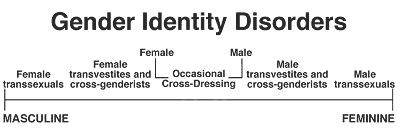
Establishing a gender identity is a process that most people take for granted, but that no one completely understands.
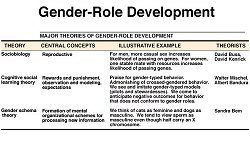 Three theories of gender development (click to enlarge)
Three theories of gender development (click to enlarge)
Scientists and sociologists agree that traditional gender roles are in many ways socially constructed, e.g. girls learn to wear dresses and boys learn to wear trousers. But no one seems to understand what makes a
transsexual child
raised in a male gender role embrace the female role as her own and vice versa. Nor can anyone explain why many intersex children raised as one sex eventually migrate back to the gender that their genetics or their prenatal hormonal environment would have predicted.
 John/Joan (David Reimer) - may he RIP.
John/Joan (David Reimer) - may he RIP.
|
Bill Summers, a professor of medical history at Yale who has studied the science behind gender and sexuality says "You have to learn somehow what it means to be a boy or a girl. You don't come born with this idea. But enough people say, 'I always knew I was a boy but I was raised as a girl' that I can't doubt they have these feelings."
Summers points to the work of Dr John Money who became famous in the 1960s for recommending and surgically facilitating the transition of a young boy with a botched circumcision into living as a girl - the so called "John/Joan" case. Money initially declared the gender re-assignment to be a success, but his work was later undermined when the girl grew up with a masculine gender identity anyway. Summers notes that "the whole idea [was] that given hormone treatment and the right social environment, you can determine gender identity. It's not really quite so simple."
The bottom line seems to be that sociologists and psychologists still don't know where gender identity comes from or why - but it is unlikely that either biology or society operates totally independently from the other. The only current certainty seems to be that when a young child decides that they are a boy or a girl and this decision contradicts their supposed physiological sex, the result is much anguish and cost to the child, the parents and the medical profession.
|

A staged but still lovely photo of a teenage Swedish transgirl.
|
Sexual Identification of Transsexual Children
It is important to note that many boy-to-girl "transsexual's" do not consider themselves to be transsexual - indeed they often actively dislike being called such - they just consider themselves to be girls and in a medical context suffer from Gender Identity Disorder (GID). The reality is that young transgirls often associate the word "transsexual" with TV documentaries featuring strange balding middle-aged men, married with children, who at the end of the program still look, sound and behave like men wearing wigs, dresses and too much makeup to their very discriminating eyes and standards. Young transgirls simply cannot relate themselves with these examples of transsexuality - their problems are totally different, and even passing is rarely one of them.
 Zach Avery, age 5
Zach Avery, age 5
Whilst there is no such thing as the typical young child with GID, perhaps a good example is Zach Avery. At first he seemed to be a 'normal boy' but when age 3 he turned around and told his mother, Theresa, "Mummy, I'm a girl". She assumed that he was just going through a phase and just left it at that, but Zach started to insist on wearing his sister's clothes and would become upset if anyone referred to him as a boy. Theresa notes that "He used to cry and try to cut off his willy out of frustration". His parents became increasingly worried by Zach's behaviour and took him to the doctors. After numerous consultations and observations, he was officially diagnosed by NHS specialists as having GID, and transitioned age 4.
|
A key, if obvious, differentiator between transsexuality emerging in children and the far more numerous instances of it emerging in an adult is the pre-puberty age at which noticeable cross-gender behavior appears in the former group. This has been confirmed by numerous studies...
|
 The age of realization of gender variance
The age of realization of gender variance
In one
study
, two thirds of transsexual boys were aware that they belonged to the opposite sex and exhibited such behavior by age 5, and 77% by age 10.
Another
study
of 137 MTF transsexuals, 70% exhibited cross-gender behavior before age 10, and another 20% before age 15.
A third
study
of 121 transgender individuals between age 18 and 65+ gives a modal average of 5 years for the age when the participants began to question their assigned gender, and a mean average of 7.9 years. Just 4% first had doubts about their gender after age 18. Over 80% of the participants in the studywere assigned male at birth.

Riley (formerly Richard) "Grant", age ten, she has never doubted that she is a girl and transitioned when age 7. (USA)
Source: Heidi Gutman/ABC
|
Most young transsexuals suppress their doubts, as one later said "my overriding need was to a keep it a secret". But a few - perhaps 1 in 20 - do come out and seek acceptance that "God has made a mistake".
For example Richard ('Richie') always wanted to wear dresses like his sister, when age two and a half his mother caught him trying to cut his penis off with nail clippers, saying "this doesn't go here". At age 7 he was finally diagnosed as having Gender Identity Disorder, his parents changed her name to Riley Elizabeth and let her go to school as a girl - where she blossomed from a "sad confused little boy into a happy young girl". The financial burden of Riley's medical care had been crippling, but her parents had no doubts - "seeing Riley's happy face now, it's worth every penny".
It seems that at least three-quarters of gender dysphoric children will eventually have sex re-assignment surgery (SRS).

Jerke
, a 10-year old transgirl
from Holland.
|
If clinical testing finds that the following conditions apply:
onset of a desire to belong to the opposite sex before puberty
|
cross gender behaviour and social role without sexual arousal
|
dislike for one's own secondary sexual characteristics
|
then core transsexuality, commonly known as "true" or "primary" transsexuality, is likely to be confirmed and appropriate sex-reassignment treatment should be started.
 Nicole Roukema (Netherlands) was born Neils but knew that she was a girl by age 3. She had transitioned by age 13 and plans to have SRS surgery when 18.
Nicole Roukema (Netherlands) was born Neils but knew that she was a girl by age 3. She had transitioned by age 13 and plans to have SRS surgery when 18.
However there still remains considerable reluctance by the medical profession to supportively treat a physically normal boy with gender identity problems - a boy who's adamantly insistent that he's really a girl. The sex re-assignment of babies and very young boys became medically acceptable in the 1970's and 1980's (indeed, perhaps too common) - but has since become discredited and unfortunately there has been a carry-over affecting young transsexuals. It seems too often require courageous and forceful parents before doctors will medically facilitate the transition of a minor.
Another interesting development since 2010 is that several studies suggest that more than two thirds boys diagnosed with gender dysphoria when pre-puberty, accept that they are actually male when post-puberty. This however opens a host of questions about the amount of medical support that they received, their access (or lack of) to puberty blockers and hormones, an inability to transition, social and family pressures, sexual orientation, and the long term physical and mental consequences - particularly on those girls still diagnosed with gender dysphoria.
 Suzannah Fleming, age 6 (inset) and now. She started hormones age 12 with the brave assistance of her mother - a registered nurse.
Suzannah Fleming, age 6 (inset) and now. She started hormones age 12 with the brave assistance of her mother - a registered nurse.
Parents
An understandable reluctance to "come out" to one's parents remains probably the greatest single obstacle to the early and successful treatment of many transgirls. On the other hand, things do seem to be improving and television and the Internet is playing a key role in this - these days most transsexual children first learn about "transsexuality" from TV programs, relating to this condition they - and often their parents - seek further information via the Internet (now an extraordinarily valuable resource) and from books.
|
|

Danielle (formally Daniel) Gomez (Mexico/USA) had SRS at age 17, while still at High school. Her supportive mother has written a book about Danielle's journey to womanhood.
It is impossible to underestimate how important the understanding and support of parents is for a young transsexual her eventual success in life. It is also difficult to underestimate how much emotional strain having a transsexual child can impose on his/her parents.
Many parents become a pillar of support and understanding, indeed there are many instances of parents going to extraordinary lengths and expense to aid their new daughter - for example moving house so they can go to a different school and avoid anyone who knew them as a boy.
In another positive example, Jamie never felt herself to be a boy, and when at age 11 she finally told her parents "You think that I am a boy, but I am a little girl!", they accepted her choice and she is now living very happily and confidently as their daughter.

20 year old
Rachel
transitioned when 17, but still visits her parents as their son Daniel. (UK)
|
On the other hand, there are also instances where the child tells the parents and the result is a nightmare of arguments and pressure. Rachel (formerly Daniel) describes how when she told her parents at age 17: "They didn't shout at me but the conversation was very heated. Mum got upset - although she said she'd guessed a while ago - and Dad was annoyed. They both said they didn't want me to dress up in the house and that I'd always be Daniel to them. ... My parents have been good to me, but they'll always see me as their son."

|
For many years Amy (shown age 19) received psychiatric treatment to "cure" her gender dysphoria.
|
Rachel is actually luckier than many girls. Enforced visits to a suitable psychiatrist (suitable for the parents at least) to treat the child's gender disorder are common. Perhaps in a few cases a "cure" is achieved, but more commonly the child suppresses his/her transsexuality, and if he persists then an eventual total rejection by one (usually the father) or even both parents may well occur. For example, Brazilian
Roberta Close
was disowned by her father, and only reconciled years later. While now a successful model and actress, for several years in her teens Roberta descended in to the seedier side of life that all too many transsexual women go through in order to earn a living.

Often transsexual children feel unable to tell their parents about their feelings and needs. This usually means that a public admission of their transsexuality is deferred to adulthood - and the delay is always much regretted. But also the resourcefulness of children should not be underestimated. For example, one text book (Man and Woman, Boy and Girl) describes how a woman secretly obtained and took hormones while still a young teenage boy. Her concerned parents eventually took her to hospital for tests to help determine the cause of the resulting physical changes, but she had had enough warning to stop and let her system clear. The doctors concluded that the changes were spontaneous and natural (some degree of gynaecomastia - male breast development - is quite normal in mid-puberty boys), and told the parents not worry.

Young transsexuals such as Kelly benefit enormously from blockers and early use of female hormones, but some fundamental physical aspects remain. (UK)
|
Medical Guidelines for the Treatment of Transexual Children
The widely followed
HBIGDA Standards of Care of Gender Identity Disorders
, a document which has previously (and increasingly controversially) been against the treatment against the hormonal treatment of under 16's, has relaxed its rules somewhat in the latest (2001) Version 6. It now states that:
"Adolescents may be eligible for puberty-delaying hormones as soon as pubertal changes have begun. In order for the adolescent and his or her parents to make an informed decision about pubertal delay, it is recommended that the adolescent experience the onset of puberty in his or her biologic sex, at least to
Tanner Stage Two.
" [on average this means about age 11 for biologic females, age 12 for biologic males] .....
|
"Adolescents may be eligible to begin masculinizing or feminizing hormone therapy as early as age 16, preferably with parental consent. In many countries 16-year olds are legal adults for medical decision making, and do not require parental consent. ....
|
"Any surgical intervention should not be carried out prior to adulthood, or prior to a real-life experience of at least two years in the gender role of the sex with which the adolescent identifies. The threshold of 18 should be seen as an eligibility criterion and not an indication in itself for active intervention."
|
|

Maité
(formerly Alexandre) Schneider started hormones age 18, but has not yet had surgery. (Brazil)
 Campbell, shown age 16, was born a boy but always considered herself a girl. She received no early medical treatment and has had to deal with a male puberty. (UK)
Campbell, shown age 16, was born a boy but always considered herself a girl. She received no early medical treatment and has had to deal with a male puberty. (UK)
Although still not coming out in favor of starting feminizing hormone treatment at a normal puberty age and delaying any sex change surgery until at least age 18, the standards do at least now allow the treatment of very young adolescents with puberty-delaying hormones and thus help prevent the socially and mentally disastrous development of normal male [secondary] sexual characteristics and appearance in an under-16 MTF school girl. In a best case this now allows age critical medical treatment to stop male characteristics developing, but female sexual characteristics optimized by early hormone treatment are still bared.
In its defense, the "Standards of Care" is clearly and understandably concerned about some instances of
unsuccessful
boy-to-girl gender re-assignment of intersex babies, such as the highly publicized failure of the gender re-assignment
David Reimer
(aka the "
John/Joan
" case), and wants to avoid any future repetition.
The Importance of Early Treatment
Unfortunately, because of the John/Joan case, and mistakes made in the past when dealing with intersex children, recent medical studies have tended to emphasize the minority (about one quarter) of gender disordered children who don't eventually have SRS, and the disadvantages of early gender and sex-role re-assignment. In particular, many advice against early genital surgery or irreversible feminizing hormonal treatment. But they neglect to consider why so many young transsexuals eventually have SRS despite the immense "corrective" pressures often exerted on them, nor do they consider whether those that don't have SRS would have perhaps enjoyed their lives more as a woman than they now are as a man.
|
If a boy is diagnosed as a transsexual then a failure to immediately start treatment is not only deferring the inevitable in the vast majority of cases, but is doing so at a considerable cost to the child's future as a girl and woman. It's indisputable that the earliest possible transition and pre-puberty hormonal and surgical treatment will offer most boy-to-girl's massive psychological and physical benefits.
|

Jonas and Nicole Wyatt (USA)
|
A rare clear example of the results of early medical treatment is Wyatt and Jonas Maines. They were born identical twins, but from a early age Wyatt rejected being a boy. His parents were very supportive, and at age 11 the twins became brother and sister when Wyatt transitioned and changed her name to Nicole. The family sought medical help from the Children’s Hospital Gender Management Services Clinic in Boston, USA. The clinic prescribed Nicole with puberty blockers and female hormone injections. The dramatic effect of this treatment is shown by the fact that at age 14 Jonas (in mid-male puberty) was 167 cm tall ( 5ft 6 inches) and weighed a 52 kg (115 pounds), whilst Nicole was still a petite 155cm (5ft 1inch) and weighed only 45kg (100 pounds).

Young boy-to-girl transsexuals have no doubts about their female gender - and early medical treatment can help them easily pass as a girl.
|
Early
transition
and commencement of treatment will permit the transsexual boy-to-girl a female childhood, a normal puberty (excluding menstruation) and allow her to enjoy her teenage years as a young woman. It's an absolutely priceless experience if a transsexual girl goes through her adolescence and growing-up as a female, with a circle of same-sex girlfriends. It's a period of time when her personality, identity and attitudes are forming, and the stage for the rest of her life is being set. She will have irreplaceable girlish memories and social adjustments that a transition later in life can never give her. Her life experience will be much more like that of other women, she will be able to talk more easily about parts of her past, her school days, and even have photo's to show her future boyfriends. For many girls, denying these experiences to her and enforcing an unwanted male gender is simply a disaster.

Monica, now in her mid-20's.
|
One successful transsexual woman 'Anna Taylor' describes her early experiences: "It never occurred to me that I was a boy. I just wondered why I had something extra. I had sessions with a child psychologist and my parents were told to bring me up neutrally. My mother tried, but my dad would slap me if he caught me playing with dolls. My mother says that if it had been up to her she would have banged on every door to let me become a girl, but my dad wouldn't stand for it."
Monica was born a boy named Morten, but always rejected being assigned as male. By her teens, her parents were worried that she was becoming suicidal and supported her transition. She finally had full SRS at age 22.

Shown age 45, Anna Taylor transitioned at 11 and began hormones at 13 after her parents found a Dutch doctor willing to prescribe them. Surgeons refused to perform her SRS until she was 18, she had surgery three days after her 18th birthday. (UK)
|
Anna ran away from home several times until, aged 8, she went to live with her grandparents who were prepared to bring her up as a girl. At age 11, started at a new school where the headmaster was very sympathetic and agreed to let her register as a girl. "For the first time no one was laughing at me. From being very withdrawn, I became very bubbly and outgoing. The only allowance they made was that I had to change in a separate cubicle for games and use the teachers' toilets. The school was afraid of another girl seeing something they shouldn't. [But] I got very depressed when the other girls started wearing bras. My own doctor wouldn't prescribe hormones for me at 13, so my grandmother took me to Amsterdam to find a doctor who would. Within a few months I'd grown very small breasts. Doctors agreed that I should have had gender reassignment surgery when I was younger but now that I was an adolescent, I would have to wait until I was 18."

Jasmijn age 9 (born as Colin). During a summer vacation her family chose her new name. (UK)
|
A recent follow-up
study
of sex-reassignment in 22 adolescent transsexuals (ten started hormones under age 16, twelve under 18) found that post-operatively in all cases all signs of gender dysphoria had disappeared, they scored normally in psychological tests and they were socially functioning well. Not a single girl/boy expressed feelings of regret concerning their decision to undergo sex reassignment. The study concluded that with careful preliminary screening, starting sex reassignment procedures before adulthood results in favorable post-operative functioning.

Puberty
Puberty can be defined as the biological developments which change boys and girls from physical immaturity to biological maturity. For a transsexual child an inappropriate puberty sets a mountain that can never be full conquered, while an appropriate puberty offers a greatly eased path to a gender reassignment, both physically and psychologically.

Laureen (formally James) Harries, age 27. She transitioned when 19 and had SRS at 22. She was a minor
TV celebrity
in the UK and is shown inset when 14. Her
life story
is atypical for a young transsexual. (UK)
|
Puberty is often a nightmare for 'gender dysphoria' children
according
to Cohen Kettenis, Professor of Psychology at the Medical Centre of the Free University in Amsterdam, "They develop an enormous dislike for their body." Most children seen by Professor Cohen react with horror to the changes that occur in their bodies at puberty. It appears that their so-called "transsexual" feelings become much stronger and they do not feel at home in the body that they now developing. Margaret Griffiths of the
Mermaids
support group says very similar things, "Some girls and boys go through Hell at puberty, they have few friends, they are bad in the school, because they can concentrate on nothing, and some have suicidal thoughts."
 Lauren Foster nee Shipton. She had SRS at age 18 and became a model and actress; she's now married (South Africa / USA)
Lauren Foster nee Shipton. She had SRS at age 18 and became a model and actress; she's now married (South Africa / USA)
When - at age 10 - Riley (who had been living as a girl since age 7) was warned by her mother that nature would soon start turning her in a man, her reaction was a horrified "Please don't let that happen ... please!".
|
Although the child may not admit to his transsexual desires at this stage, the parents will often start to have some concerns about their son. The onset of puberty is a critical point as the child is faced with his own undesired physical masculinization, often combined with a great jealously of girls and their physical changes, by age 15 some 90% are exhibiting feminine behavior. This is the point where many transsexual children finally admit to their wish to be a girl and they, or their parents, seek help.
|
 Kelly at the start of her transition. (UK)
Kelly at the start of her transition. (UK)
One now happily post-SRS girl described how she felt at puberty: "That was the hardest. My own body was staging a mutiny, even." At 16 she finally confessed to her secret to her parents who took her to several doctors but they wouldn't help, "I knew I couldn't be happy letting my body masculinize on and on. And so at 17 I graduated from high school and found hormones on the street."
Now 21, Zoe concurs about puberty: "When puberty arrived I was repulsed by my erections and deepening voice. At times I felt suicidal." Jamie Cooper was 12 when she wrote her mother a letter saying that she should have been born a girl, they sought medical advice and were told that it could just be puberty, the feelings deepened but she had to wait until she was 16 before receiving hormone treatment - she transitioned on her 16th birthday.
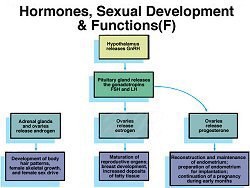
|
How hormones affect a girls body during puberty (click graphic for large version)
|
A lot more information about puberty and its effects is given in the separate
article here.
Hormones and Puberty
Body shape is controlled by estrogen and testosterone. During puberty, while boys are amassing bone and muscle thanks to their developed testes pumping out androgens (particularly testosterone), a high concentration of estrogen in the female body results in the typical girl gaining nearly 35 pounds (15kg) of so called reproductive fat deposited on the hips and thighs rather than on the waist. Another female hormone, progesterone, also plays a significant and complementary role, most particularly in the development of breast tissue.
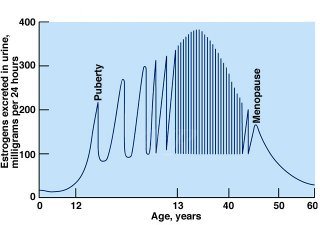 Oestrogen levels in Women
Oestrogen levels in Women
 Testosterone levels in Men
Testosterone levels in Men
The changes in hormone levels at puberty are dramatically different between boys
and girls, unsurprisingly this results in dramatically different physical changes.
|
Professor Cohen's policy is that if it appears that the gender dysphoria feelings are becoming stronger then they should be prescribed puberty blockers to temporarily halt puberty until they are 16. When they are 16, and quite certain that they have the wrong body, they can be prescribed hormones as well as to begin to change their outward appearance to more closely match their chosen sex, "After that comes the actual sex-change operation".

Breaking all the guidelines Marilia (formerly Errolclaud) Gabriela started hormones at age 13. She had SRS at 22. (Brazil).
|
Hormone Treatment for Young Transsexual Girls
A treatment model developed for intersex children with male testes but assigned as female has occasionally been applied to young transgender children. In order to maximize physical feminization, low level estrogen treatment of the young transsexual boy-to-girl often begins at age 8-9 years. Before the onset of a natural puberty (at about age 11, but it can vary ±2 years) a bilateral
orchiectomy
(castration) is performed to remove the testes and hormonal treatment is then increased (additional estrogen, later supplemented with progesterone) to initiate a female type
puberty
.
|

Nina (formerly Guido) transitioned at age 11. She's is pictured nearly 3 years later, age 13. (Netherlands)
|
When an orchiectomy is performed before puberty, the results in terms of increased physical feminization and decreased masculinization are much more dramatic than when it is done after puberty. However many Western doctors are very reluctant to perform any irreversible surgery, or even prescribe feminizing hormones, for a transgender child under age 16. Instead, they often prescribe GnRH analogues (commonly known as 'puberty blockers') such as Zoladex (Goserelin Acetate) and Lupron (Leuprolide Acetate). These prevent or dramatically reduce gonadal hormone production, including testosterone, thus preventing the onset of the masculinizing changes of adolescence. The drug is administered with a nasal spray, or via a weekly or monthly subcutaneous injection into the abdomen. While the treatment does nothing to promote female physical characteristics in the girl, it does prevent or greatly slow male type puberty with its physical effects, and several Dutch studies have confirmed the effectiveness of such treatment.

Puberty blockers have the important advantage of gaining time whilst the transgender child considers and reconfirms their choice of gender. The 2010's have seen a huge increase in the number of apparently transgender children, but anecdotal reports indicate that up to a third change their mind within a year of transitioning. Another big advantage of blockers for a boy-to-girl is that they don't have to start taking a high dose of estrogen whilst pre-teen. An 11 or 12 year old boy is actually shorter than the average girl of the same age, and starting estrogen therapy at that age may restrict their height to under 5ft (about 151 cm) - very short even for a girl. Obviously every tgirl is different, but delaying estrogen treatment until age 13 or 14 is likely to result in an average female height, whilst 15 may result in an above average height for woman, but not excessively so (i.e. ideal for a model).
Unfortunately GnRH analogues are expensive drugs, but they are to be much preferred in adolescents over the cheaper anti-androgens such as Aldactone (Spironolactone) and Androcur (Cyproterone Acetate) which are commonly prescribed to post-puberty transsexual women.

Cambell Kenneford. Shown age 10, age 16 (when she transitioned and was about to begin hormones), and age 20 (after SRS). (UK)
|
The UK's NHS has become one of the most progressive medical organizations in regards to the treatment of
transgender children.
They will now - if appropriate - prescribe hormones from age 12, and puberty blockers before that.
Even if it not possible to begin female hormonal hormonal treatment before a male puberty has commenced, the results can still be remarkable results if started whilst the body is still at its most receptive age - the critical puberty years between about 11 and 17 (depending on the individual), but the earlier the better. It is no coincidence that so many transsexual women who famed for their looks had begun taking hormones by 17 -
Jenny Hiloudaki
,
Tula
,
Hari-su
,
Roberta Close
,
Dana International
, etc.

|
|
Vicky Nicole Eriksson
(born Victor), pictured age 18. (Sweden)
|
A typical example is Nicole Vicky Eriksson, born in 1995 in the small village of Stråtjära, in Hälsingland, Sweden. She was christened Victor, but always knew that she was a girl trapped in the body of a boy - when asked age 3 what he wanted to be when grown up, she responded "A woman!". Her family and the people of her home village accepted her transgenderism, and she began taking hormones at the age of 16 years, with her sex change operation planned for 2013, when she reached 18. She moved to Stockholm to study fashion and dreams of a career as a model, and her
ImVicky blog
already has a huge following.
 Ashlyn Parram (born Lewis) was not allowed to sit an exam at her school because she was wearing a girls uniform, including skirt. The headmaster only relented after being shown the Equality Act 2010. Shown age 11 and 16. (UK)
Ashlyn Parram (born Lewis) was not allowed to sit an exam at her school because she was wearing a girls uniform, including skirt. The headmaster only relented after being shown the Equality Act 2010. Shown age 11 and 16. (UK)
Doctors certainly seem to agree that giving - for example - a 13-year-old transsexual boy-to-girl doses of estrogen will make her physically far more attractive as an adult women. However they also agonize about the possible negative consequences - and perhaps their potential legal liabilities from prescribing female hormone to "boys".

Young transsexuals often struggle to understand the medical "best practice" guidelines that affect their life. Riley (pictured right, age 9) was when 12 diagnosed both estrogen and testosterone blockers. It was explained to her that this would make her body more feminine, her voice won't deepen and that she could eventually develop breasts - but that she would be infertile. Her reaction was "But I can adopt babies ... why can't the doctors take my testicles off now?"
A rare example of the medical community responding to the needs of young transsexual may have achieved in Germany when it was revealed in 2007 that doctors had prescribed puberty blocking and later female hormones to a 12 year old 'Kim', formerly Tim. At age two, Tim was trying on his older sister's clothes, playing with Barbie dolls and saying "I'm a girl." By age four Tim was refusing to get to his hair cut and wanted to cut of his "thing", for the sake of a normal life his parents increasingly accepted their son Tim as being their daughter Kim.

Kim Petras
age 13. Born in August 1992, in 2008 she became famous as the world's youngest post-SRS transsexual at age 16. (Germany)
|
The situation reached a crisis when Kim grew increasingly distressed at becoming like other adult transsexuals with big hands and deep voices, whom she thought looked ridiculous when they dress like women. Her father said "We saw Kim as a girl ... not as a problem. ... [she] reacted badly to the first signs of puberty... At that stage we realized that she was terrified of growing facial hair and her voice breaking".
Kim’s parents decided to help her get a sex change and consulted psychiatrists across Germany. Some condemned their support of their child’s desire to undergo a sex change, or suggested that she be kept under observation in a closed psychiatric ward. But Dr Bern Meyenburg, the head of a clinic for children and adolescents with identity disturbances at Frankfurt University, concluded that the child was serious. He wrote in his diagnosis: "Kim is a mentally well-developed child who appears happy and balanced. ‘There is no doubt of the determined wish, which was already detectable since early childhood. It would have been very wrong to let Kim grow up to be a man."

A transgender group meeting at a university - in recent years "Transgendered" has finally been added to Gay, Lesbian & Bisexual.
|
Dr Meyenburg had once strongly opposed hormone treatment for children but changed his mind when one of his patients refused to listen and ordered hormones over the internet, then went abroad at 17 and had a sex change operation for a few thousand euros. Dr Meyenburg admits that he was angry at the time, but said that today the woman is a law student and one of his happiest patients. He now allows young patients to enter hormone treatment early, before puberty complicates a sex change. "They simply suffer less," he said, "it would have been a crime to let Kim grow up as a man".

Kim Petras
, age 21
|
Dr Achim Wuesthof, who is now treating Kim at a clinic in Hamburg, said: "Imagine a man who suddenly starts growing breasts or a woman who starts growing a beard against their will – that is how Kim and people like her experience puberty." Kim was thus prescribed female hormone therapy when just 12, and by age 14 was fully transitioned and living as a girl - with her identity and medical insurance cards changed to her new name and female sex. German law only permits sex-assignment surgery (SRS) at age 18, but Kim apparently had this in November 2008 - just two months after her 16th birthday. This created headlines around the world that proclaimed her to be the youngest person to ever have had SRS, although that claim is false - even excluding XY
intersex
children. Just two examples are the sad case of David Reimer (age 22 months), and Victoria Beltran whose parents managed to get her surgery when just 15. Also, hundreds of SRS procedures are performed every year on under-18's in Asia and South America, and it seems very likely that some are under 16.
Kim handled the intense media interests surrounding her surgery with great honesty and confidence, for example she told one interviewer "I was asked if I feel like a woman now - but the truth is I have always felt like a woman - I just ended up in the wrong body." Since age 18, Kim has concentrated on developing her a career as a singer.
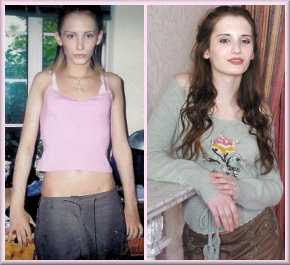
Angel (formerly Oliver) Wheadon began taking her Mum's HRT pills at 9, transitioned at 12 (shown left at 13), was prescribed oestrogen hormones at 14, had SRS at 17, and is shown right age 21. (UK)
|
Effects of Early Hormonal Treatment
A doctor now treating transwomen says: "I began working with transgendered people in their 20s. The people in their 20s were socially in good shape. But they were having trouble getting their physique to conform to their identity. I knew the twenty-somethings could have better chances of passing if they were treated earlier."
|
Early hormone use (i.e. during puberty) in a trans-girl allows a typically normal female body shape to develop, with significantly more fat and less muscle than otherwise, the girls post-puberty body shape and "figure" will become far closer to female than male norms in its proportions.

|
Amanda Lear
(France/ UK/...) may have started hormones at 15 - depending what birth date you accept.
|
In general, increased levels in the blood plasma of estrogen and progesterone will stimulate and promote the growth of female secondary sexual characteristics (breasts, fat distribution, pubic hair pattern, ...) while the reduction in the levels of androgens such as testosterone will, if early enough, completely prevent the development of male ones (deepening of voice, facial hair, muscular development, ...).
Female hormonal treatment has a dramatically greater effect if begun before a male puberty has started (on average age 12, but plus or minus 2 years) than after a male puberty has completed (on average 17, plus or minus). This is a severe problem given the great reluctance to doctors to assist transsexual patients under age 18. Incidentally, the anticipated and achievable benefits from starting female hormones decline rapidly in the decade after puberty ends.

A holiday snap of a transitioning 19 year MTF, happily showing the early effects of her hormone treatment. (UK)
|
Maximum possible feminization occurs if hormonal treatment begins just before a male puberty would have start started. Very conveniently, girls tend to start puberty two years earlier than their male peers, so high dose hormone therapy intended to initiate a full female type can be safely started by age 11, although it in practice it is often deferred to 12 or even later, particularly if the individuals physical development allows that. If her testes were removed in infancy or childhood, then for health reasons low level hormone therapy should be begun by age 9 - an age at which many girls begin to notice some initial puberty changes, in particular the development of breast buds.

Ashley transitioned in her late teens - young enough for 18 months on oestrogen hormones to have considerable effect. (USA)
|
As indicated already, surgeons have become very reluctant in recent years to perform a bilateral
orchiectomy
on even young intersex patients, let alone gender dysphoric boys; however failure to do so does accept the slight risk that even suppressed testes might still produce enough androgens for a very sensitive body to react to them. The nightmare scenario is a confused body going through a double male and female puberty - the girls hips broaden and her breasts swell under the influence of estrogen therapy, but simultaneously her voice deepens and facial hair appears due to the testosterone being produced by her testes.

After legal debate Johanna (formally Johannes) Bulow (Germany) was allowed puberty blocking drugs at age 12 and female hormones at 13. She's shown age 14, and (inset) age 15 holding her new identity papers.
There seems to be no consensus amongst clinicians as to whether pubertal development is more 'natural' in XY girls with estrogen producing ovaries, than in XY girls (more commonly intersex rather than transsexual) taking hormone replacement therapy (HRT) following early orchiectomy. This lack of consensus can actually be considered a good indication of the great effectiveness of early hormone therapy.
The reduction in levels of "male" androgen hormones caused by estrogen treatment will also have some slight effect on the skeleton - reducing male type rugged'ization and enhancing female type features, for example slightly broadening the pelvis and helping reduce the girls adult height (by perhaps an inch or two) compared with if she had experienced a male puberty. However, while hormones play an important role in post-pubertal body shape, it's thought that the male "Y" chromosome is mainly responsible for skeletal growth. As a trans-girl is genetically "XY" she will thus still experience some a degree of skeletal masculinization, even if she commences female hormone treatment at 11 or 12. In general, her physical characteristics as determined by her skeleton (height, skull, hand & feet size) will lie between the male and female norms post-puberty - although more towards the former than the later. This not necessarily bad as the western idea of feminine beauty is for tall and leggy women. As an adult, the woman will typically be both tall compared to the average woman (67½" vs. 64¼") and have long legs - both absolutely (32½" vs. 30") and relative for her height, ideal for those girls with ambitions as a model! [For more information about average male and female body sizes, see the
article
on this site]

"Lucy Parker is a typical teenage girl, obsessed with clothes, boys, make-up and shopping." Lucy (formerly Richard) transitioned at 16 and a BBC documentary followed her having breast augmentation just days after her 18th birthday allowed this. (UK)
|
In a genetic girl, her increasing production of estrogen during puberty causes her skeleton to mature so that growth eventually stops. Estrogen treatment can speed up this bone maturation by accelerating the completion of growth in the growth plates (the zones of growing cartilage near the ends of children’s bones) and thus suppresses growth somewhat, by up to two inches. Pediatric endocrinologists sometimes prescribe large doses of estrogen (usually Ethinyl Estradiol) for a period of several years to deliberately restrict growth in excessively tall girls, and the same technique can be used to help induce in young transsexuals a final height in the typical female range of 61 - 67".
However, obtaining supervised treatment for a transsexual boy-to-girl is difficult, arguing that height is not a disease; endocrinologists are becoming increasingly reluctant to treat even a genetically female "XX" adolescent unless bone growth X-rays show that excessive adult height for a female (over 71") appears likely.

Thalita Zampirolli began hormones age 15 and had SRS on her 18th birthday. She also has had 260g silicone breast implants. Shown age 24. (Brazil)
|
The following table compares the effects of beginning female hormone treatment before a male puberty starts (which is typically age 12), with beginning treatment after male puberty has completed (i.e. after about age 17). Extensive experience with intersex but "XY" female individuals indicates that for the very best results, low-level estrogen treatment should be started at age 9, and stepped up to "puberty" levels at 12.
|
Commencing treatment during puberty will produce mixed results between the two poles - e.g. the voice may have already deepened irreversibly but facial hair growth is prevented or greatly reduced.
|
Desired Characteristic
|
Pre-Puberty
Hormone Treatment
|
Post-Puberty Hormone Treatment (Note 1)
|
Prevent skeletal masculinisation, e.g. large hands & feet; square jaw
|
Some benefit
(e.g. growth may terminate earlier, less heavy bones)
|
No
|
Modest height, e.g. less than 70 inches, 180 cm
|
Yes (note 4)
|
No
|
Broad female type pelvis
|
Some benefit
|
No
|
Soft clear skin
|
Yes. Also little or no acne during puberty.
|
Substantial improvement
|
Prevent facial beard hair
|
Yes
|
Little effect
|
Thick female type scalp hair and forehead hairline
|
Yes
|
Hair loss ceases, slight reversal of balding
|
Female pubic hair pattern. Hairless trunk and limbs.
|
Yes
|
Substantial improvement after prolonged treatment
|
Feminine type voice
|
Yes for most children
(Prevents the dropping of the larynx, also known as the breaking of the voice)
|
No
|
No "Adams Apple"
|
Yes - little to none
|
No, surgery required.
|
Slim neck
|
Possibly a slight benefit due to skeletal changes
|
No effect that's not ascribable to dieting or surgery.
|
Minimise muscular development
(Note 2)
|
Yes
|
Some reduction
|
Female type subcutaneous fat deposits and body contours (Note 2)
|
Yes
|
Variable redistribution. Increased fat deposits most significant on hips, buttocks & thighs after prolonged treatment
|
Reduced weight (Note 2)
|
No
|
May actually increase unless supported by dieting and exercise.
|
Small waist
|
Some benefit
|
May actually increase unless supported by dieting and exercise.
|
Full and mature "Tanner V"
breast development
(Note 3)
|
Substantial benefit
Breast development 1 or 2 cup sizes less than mother / sisters
|
Variable from slight to substantial breast development, Tanner V very unlikely.
|

Notes:
1. Effects of hormone treatment vary considerably by individual, and can take 2 to 5 years to fully achieve. The longer after male puberty that female hormone therapy is started the less effective it will be - and the effects decline rapidly rather than on a linear scale. E.g. results are considerably more dramatic with an 18 year old than a 28 year old, but not usually very different between a 38 year old and a 48 year old. Other treatments can help feminise some characteristics in adult transsexuals.
|
2. Oestrogen hormones tend to deposit fat. Sensible
dieting
and suitable exercising (e.g. aerobics, not power lifting!) will greatly assist and magnify the effects of hormones in developing a female type figure and body shape. The objective should be a nicely rounded waist-hip ratio (WHR) of 0.7-0.8, a range which is a key visual "female indicator".
|
3.
Breast development
will vary considerably depending on the individual's genetic make-up and the time from puberty. From hormones alone, a typical "natural" result in young transsexuals is one bra-cup size less than the girl's mother and sisters.
4. Dr Stoker of the Boston Children's Hospital suggests that without hormone treatment one transgendered girl in the UK would have become 6ft 4in tall, rather than an acceptable 5ft 10in. However excessive early oestrogen intake can also result in stunted growth and below average female height.
|
(Right, photos from
The Teen and Transgender Comparative Study
. This compares adult transsexual women with girls of puberty age (12-14) that have similar general characteristics.)
|
Overall, the physical results of early hormonal treatment should be extremely successful, the girl developing a well feminized physique with full breasts (although rarely as large as the girl would like), no beard, plentiful scalp hair, and an unbroken female type voice. It's difficult to over-exaggerate just how great these advantages are, and how much of a disaster each year of delay is for the transsexual girl whose skeleton and body is rapidly turning in to that of a man. The end of puberty is a fundamental and irreversible physical marker, from which the plausible effects of feminizing hormonal treatments on the body of a transgirl/woman decline with depressingly rapid speed. For any transsexual woman starting treatment when already physically mature (and this merely means age 20 onwards), a muscular and robust stature; a deep and masculine sounding voice; obvious facial beard growth; and a receding hairline, are just four of the immediate challenges that may seriously threaten her ability to
pass convincingly
as a woman. She also faces the high cost of electrolysis,
breast augmentation
,
facial feminisation
, ... etc.
 Wendy (UK) at age 17, when doctors would not prescribe her hormones despite her parents full support for her transition.
Wendy (UK) at age 17, when doctors would not prescribe her hormones despite her parents full support for her transition.
Hormone Regimen's in Transsexual Girls
There seems to have been little published research with regard to the dosage for hormones in young transsexual patients, however research which relates primarily to Androgen Insensitivity Syndrome (AIS) patients is also probably applicable to transsexual girls. Zachmann et al cite one AIS patient who had undergone orchiectomy in whom estrogen administration was started at the earliest estimated pubertal age of 10.3 years in the form of Premarin 0.625 mg three times weekly. It was found, however, that this stopped growth of the girl prematurely and the authors felt that it would have been better to have given the patient 0.005 - 0.01 mg ethinyloestradiol daily, instead. From studies of patients with Turner syndrome it has been suggested that to ensure normal pubertal growth, physiologic estrogen replacement should be started at the appropriate bone age of about 11 years and should not be delayed in the hope of achieving a greater mature height. Batch et al suggest a regime of 5 micrograms of ethinyloestradiol daily for the first 6 months, increasing to 20 micrograms daily by the end of puberty.

|
Katie (USA), shown age 16 and while still in High School. She transitioned when age 10 and her parents fought for her right to attend school as a girl. Although on female hormones for many years, she was still waiting for her SRS in early 2003, now 19.
|
Soule et al. suggest that the best course of action may be to perform a orchiectomy just before puberty (at 11 years in a case quoted) followed by estrogen therapy (ethinyloestradiol 2 micrograms daily, gradually increasing to 20 micrograms over 2 years, in the case quoted) with regular bone density measurements. This policy, it is suggested, reduces any slight risk of malignant transformation of the gonads and ensures adequate estrogen activity throughout the critical years of bone accretion.
|
However, estrogen levels are higher in XX girls than in XY boys, even in childhood. XX girls start producing estrogen at 8 or 9 (i.e. a year or two before breast development) so several clinicians therefore recommend early estrogen supplements in XY girls, irrespective of whether or not the gonads are in place. Dr. Stanhope suggests 1 microgram ethinyloestradiol per day from age 8-9, with an increase at about 11-12 years.

Early hormone treatment is not a miracle, but the benefits such as female hair pattern, no beard growth, no Adams Apple, no broken (deep) voice, breast development are immense.
|
Females Hormones and Attractiveness
A very awkward problem for psychologists advocating delayed hormonal treatment for young transgirls is that as result they will be physically less attractive as a woman to men.
|

There is a strong and direct correlation between a girls oestrogen levels during puberty and how attractive and feminine she is perceived as a woman. For example, the hormone has lasting effects on bone growth and tissue formation as well as the skin’s appearance during the average seven-year-long puberty. Miriam Law Smith of the University of St Andrews states the hormone has a hormone has a crucial role in determining facial appearance, giving 13-year-olds doses of estrogen will "certainly may make them more attractive [to men]" although she adds "who knows what other effects the hormone may have?" As regards the last comment, pubertal girls who have been prescribed estrogen to prevent excessive height (over 6 feet) may according to one study subsequently suffer from lower fertility.
 Kelly van de Veer (Netherlands) had SRS at age 19
Kelly van de Veer (Netherlands) had SRS at age 19
Passing and Sexual Orientation
There seem to have been no formal clinical studies, but it seems certain that young male-to-female women are far more likely to complete their transition and settle well into their new lives than those who transition at a later age.
|
 14 year old Jamie (left) and 15 year old Danique are unambiguously girls after their transition. (Netherlands)
14 year old Jamie (left) and 15 year old Danique are unambiguously girls after their transition. (Netherlands)
About 95% of natal "XX" women consider themselves as being heterosexual. In comparison,
studies
of the sexual orientation of post-SRS transsexual women indicate that only half are heterosexual and exclusively select males as sexual partners; nearly one-fifth are lesbian and sexually attracted only to females; and about one-third are bisexual. However these studies cover all age groups (with an average age in the 30's or even 40's), and are almost certainly not representative of the relatively few young transsexuals who transition before the completion their male puberty. It is very likely that when compared to older transwomen, a far higher percentage of young transsexual women identify themselves as heterosexual and attracted to men. Indeed, for under 21's, I would suggest that there are very few girls who do not consider themselves to be heterosexual, and have or would like to have, a boyfriend.
 Roberta Close started hormones at age 16. Even as an undis-covered teenager, her attraction to and success with men is undoubted. (Brazil)
Roberta Close started hormones at age 16. Even as an undis-covered teenager, her attraction to and success with men is undoubted. (Brazil)
Unlike older transsexual women, young transsexual girls rarely have had any sexual activity before they transition, and if they do it's likely to be of a homosexual nature, generally playing a female role during intercourse. Mentally they are often only erotically stimulated by men, although overall their sexual urges may be very low because of puberty suppressants. When released from such drugs and placed on hormone therapy, they become just as interested in boys and men and sex as other girls of their age - if not more so. "G", a nearly 16-year old transgirl undergoing an intense female puberty thanks to being on hormones illicitly obtained by her parents, may be quite typical when she writes: "I can't stop thinking about my [neo-vagina] ... I want to be ['screwed'] by any guy in sight. I was even thinking about my teachers and my best friend's dad." But this girl does not expect to undergo SRS for years yet.

Two sisters, Alina - in red - was previously a brother. (Russia).
|
Unlike older transsexual women - again - young transsexual girls rarely have any problems passing easily and naturally, and assimilating themselves as women. For example, in one survey (Sex Reassignment of Adolescent Transsexuals: A Follow-up Study, Cohen, 1997) of young transsexuals, all the male-to-females were satisfied with their appearance after hormone therapy, and it was the interviewer's observation that it was difficult to discern any signs of their [genetic] sex. Most of the girls had been approached in a flirtatious manner, and not one had been approached by strangers as if they were still of the male sex, 60% expressed satisfaction with their vaginoplasty, and had experienced sexual intercourse without problems. The author of the study suggested that part of the adolescents' success was due to the fact that they more easily pass in the desired gender role because of their convincing appearance. With one exception the voices of the girls were not male sounding, and early anti-androgen treatment apparently had acted in a timely way to block facial hair growth and the lowering of the voice.

Young transitioners rarely have the difficulty in passing faced by most over 20's. A TS girl with a girl-girl friend. ... I will let you work out their genes!
|
Somewhat disputably, the study also stated: "Another aspect of this relatively positive outcome may be attributable to the criteria for treatment eligibility. ... [The] patients selected for early treatment not only are among the best-functioning applicants, but probably they also belong to the subtype of so-called "homosexual transsexuals" (that is, individuals who are, before SRS, sexually attracted to same-sex partners) .... They are also referred to as "primary" or "early-onset" transsexuals."
Nevertheless, success in passing may well be an important factor in young trans-girls being far more likely to have a heterosexual sexual orientation than transsexuals who transition as adults. It's clear that trans-women who transition at a young age are almost always physically able to go
stealth
, they typically do as soon as possible, and often quickly begin to have boyfriends and eventually a husband. The desire for a normal relationship with a man tends to pull the transwoman away from any open acknowledgement of her transsexuality and male past, she feeling (unfortunately often correctly) that the relationship may not survive this becoming known. In the balance between personal happiness and revealing "the whole truth and nothing but the truth", most people choose happiness. The experience of this site is that when a young transsexual out's herself, she often soon regrets it - and for good reasons.
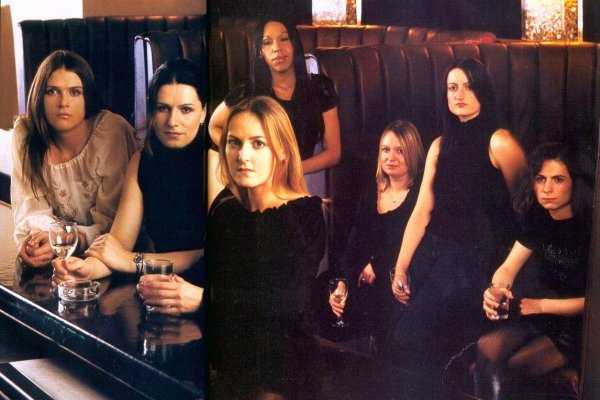 These young transsexual women featured in the July 2002 edition of the UK magazine Marie Claire.
Nina (second from left) was 22, Jamie (back, fourth from left) was 16, and Zoe (first from right) was 21.
Jamie eventually had her SRS just five days after her 18th birthday - as soon as the Standards of Care permitted and her surgeon could perform the operation.
These young transsexual women featured in the July 2002 edition of the UK magazine Marie Claire.
Nina (second from left) was 22, Jamie (back, fourth from left) was 16, and Zoe (first from right) was 21.
Jamie eventually had her SRS just five days after her 18th birthday - as soon as the Standards of Care permitted and her surgeon could perform the operation.
 These four post-operative transsexual women (ages 23-27) from Thailand appeared in some
editions of Maria Claire in 2006, making an interesting contrast to the picture above.
These four post-operative transsexual women (ages 23-27) from Thailand appeared in some
editions of Maria Claire in 2006, making an interesting contrast to the picture above.
 Jenny Hiloudaki was born Yiannis in 1981. He began secretly taking female hormones when just 13, and had Sex Reassignment Surgery age 20. She was 'outed' at age 29, but two years later was voted 'Greek Woman of the Year'.
Jenny Hiloudaki was born Yiannis in 1981. He began secretly taking female hormones when just 13, and had Sex Reassignment Surgery age 20. She was 'outed' at age 29, but two years later was voted 'Greek Woman of the Year'.

In the early 1990's Deborah Davis had sex reassignment surgery at age 17. Twenty years later it is still very rare for teenager's to be able to have such surgery.

|
|
Athena Javaher, shown age 20, had SRS when 18. (Iran)
|
Sex Re-assignment Surgery
After hormones and transition, the next and final step is
sex-reassignment surgery
. Extra-ordinarily, only about 1% of SRS operations performed by western surgeons are on girls under age 20 (almost all of whom are 18 or 19). The reasons seem to be a combination of the Standards of Care guidelines, the need for a two year real life test when a hormone supported transition can only begin no earlier than age 16, money, the requirement for parental permissions in some countries, the reluctance of surgeons to operate on very young transsexuals, and the extreme rarity of under-20 (or indeed under 25) surgery candidates compared with older candidates - the median average age of European transwomen at the time of their SRS is mid-to-late 30's, with a mean average age of around 40.
|

Angel Paris-Jordan (formally Oliver Whedan) had SRS and breast implants when just age 17. (UK)
|
By interesting contrast, one study of 195 Thai male-to-female transsexuals found that "many participants had transitioned very early in life, beginning to feel different to other males, and identifying as non-male by middle childhood. By adolescence many were living a transgendered life. Many took hormones, beginning to do so by a mean age of 16.3 years, and several from as early as 10 years. Many underwent surgeries of various kinds, on average in the twenties, with one undergoing SRS as early as 15 years".

Claire Farley. The film
Red Without Blue
documents her transformation from Alex and her evolving relationship with her twin brother. (USA)
|
Clair (formerly Alex) Farley told her parents that she was gay in when 13. After a suicide attempt age 15 she told a councillor "I feel that I should be a girl". She finally transitioned at age 18 and began hormones, over the next year: "My hips widened, my thighs thickened and tiny breasts started to appear". She finally had her SRS at age 23, "a few days later I pulled out a hand mirror and got a first glimpse of my new vagina ... it was badly bruised but I couldn't have been more excited, I was all woman".

Lucille age 21 on a magazine cover, and a photo six years later. (Austria)
|
Another extraordinary tale of determination is Lucille. Born in 1986 as Lucien, he knew even at pre-school that he was a girl, not a boy. By secondary school his long hair and wearing of girl’s cloths led to teasing and worst. He sought medical help but faced three year waiting lists. After leaving school he obtained a job as a female hair dresser but lost it after being out'ed. In desperation he persuaded a private medical clinic that he was from a noble family and had well-to-do parents. In June 2006 - age 20 – the clinic performed sex reassignment surgery and breast augmentation on her. Unfortunately she couldn’t pay the €18,000 bill and the subsequent court case made headlines in Austria and Germany. Although sentenced to six months in jail, she had no regrets, saying “My suffering was enormous… I had finally become a woman because I am a woman. I am a real woman. I have a vagina, can experience orgasm. [My breasts are also very important and] now I have 345 millilitres of silicone per breast.” Happily the sentence was suspended and she eventually paid the bill. Lucille married soon after her SRS and is now a successful artist.
Parental Support - Changing the Rules
Considering all the advantages of early treatment of the young transsexual, it's unsurprising that it is now increasingly demanded (and obtained) by increasingly knowledgeable transsexual children and their parents.
|

The stories of young transsexuals are often very news worth. Melanie McPryce (formerlyTom McGlone) transitioned at 16, started hormones at 17 and spent €22,000 to have sex-reassignment and breast augmentation surgery in Thailand the day after her 18th birthday. The News of the World newspaper gave her story a centre page spread and hopefully suitably recompensed Mel and her mum.
|
Supportive parents are undoubtedly influencing a 'system' and medical profession that was in the 1990's retreating rapidly from early treatment and accommodation of young transsexuals. After a decade long reaction to the tragic David Reimer affair, it has become recognized that it is necessary to separate and differentiate between the voluntary and non-voluntary gender reassignment of children. While numbers are still small, there is nevertheless an increasingly willingness by doctors and the "system" to support and aid the early reassignment of children. The revised guidelines in the current version 6 of the "Standards of Care" issued in 2001 makes it slightly easier for young transsexuals to officially obtain treatment - including puberty-delaying drugs but not female hormone therapy for those reaching their teens.

But doctors still face circumstances where a failure to support young transsexuals in order to comply with guidelines can seem at best totally unreasonable. For example, in 2006 a 5-year boy was allowed to enrol in kindergarten as a girl with a "gender-neutral name" in Florida, USA, having been diagnosed with gender identity dysphoria (GID) two years ago earlier. The parents said the child refused to wear boy's clothing and repeatedly said she hated having a penis - often trying to hide it between her legs. Officials said that were already a number of trans-students in the school system but none as young as kindergarten age, they expected that the youngster would go unnoticed as a girl. Can she be denied female hormones at age 11-12?

Meanwhile, in Japan a 7 year old boy with GID, Ryoko Kanda, has been allowed to enrol as a girl at a school is in the prefecture of Hyogo, about 270 miles west of Tokyo after being diagnosed with gender identity disorder at age 6. The school has not told other parents about the switch, and a spokesman for the local school board said there had not been any complaints from other students or from the boy's parents since his enrollment. He stated that the boy's name is listed with girl students, she uses the girls' bathroom, attends a girls' gym class and wears a girl's swimsuit at the school pool. The official also said "At this point, we are relieved that the child was accepted into [second] grade and is being raised in a healthy manner", he added that the school district would watch his case closely and reassess the decision as the boy reaches puberty. Katsuki Harima, a psychiatrist specializing in gender identity disorder at Tokyo Musashino Hospital, said the decision to allow the boy to enrol as a girl seemed appropriate, but would get complicated as he grew older. Harima said the boy is not old enough to determine whether he really has the disorder. A boy who behaves like a girl does not necessarily have gender identity disorder and he could discover as he grows older that he wants to be male.
Progress since 2001
This article was first written in 2001, revisiting it a decade later there has been some progress in the treatment of young transsexuals. There can be almost no doubt that a series of highly publicized transgender success stories - basically young boy-to-girls who thanks very substantially to early medical treatment look and sound like teenage girls - have helped this immensely. Another generally very positive development has been the appearance on social media such as YouTube, Facebook, Instagram and Twitter of openly transgender girls who then act as an inspiration and source of information for other girls
|
 Success stories: from the left Cadence, Larissa, Kim, Marti, Devon and Jackie
Success stories: from the left Cadence, Larissa, Kim, Marti, Devon and Jackie
 Other openly transgender teenagers on social media have included, from the left, Maya, Brittney,
Luxeria, Michelle and Vicky.
Other openly transgender teenagers on social media have included, from the left, Maya, Brittney,
Luxeria, Michelle and Vicky.
Little by little an increasing number of clinics are now willing to help young transsexuals with medication and even surgery at an early age. Two examples:
USA: In 2007 the pediatric endocrinologist at the Children's Hospital Boston, Dr. Norman Spack, set up a clinic for pre-adolescent transgender children. Dr Spack uses drugs to delay the first stirrings of a youngsters' puberty, typically age 12 to 14 for a boy. The effects of these puberty-blocking drugs are reversible but is not the case with hormones. Dr Spack is flexible about the age he prescribes estrogen - i.e. he's not rigid that the child has to be age 16+, but will only do so after months of consultation with the patient and her parents. He says "When kids take this step, they are rewriting their own future: The hormones have a powerful, pervasive effect, changing their height, breast development, and the pitch of their voices ... You have to explain to the patients that if they go ahead, they may not be able to have children. When you're talking to a 12-year-old, that's a heavy-duty conversation".

Matti, age 15
|
UK: In 2011 the Portman and Tavistock Clinic gender identity service was set in north London to provide treatment to transgender children under the age of 16. It was initially deemed controversial due to the patients' ages - with critics arguing that the youngsters lacked the ability to consent to the therapies. However in just 2 years the clinic received 142 referrals of children aged 11 to 15 from parents and carers. Dr Polly Carmichael, director of the service, said it was "better for children not to have gone through puberty before transitioning". But she added: "You are asking someone aged as young as 11 to make big decisions about their adult life and identity. We have to be very careful to keep options open".

Perhaps the most important recent development is that the famous/notorious "Standards of Care for the Health of Transsexual, Transgender, and Gender-Nonconforming People" (which very few medical professionals will dare not to conform to) has now advanced a tiny bit as regards young transsexuals in its
seventh edition
, published in 2011. It now allows the use of puberty-suppressing hormones - but only when puberty has already begun! It also says that "Adolescents may be eligible to begin feminizing/masculinizing hormone therapy", essentially from age 16.
 Elaine at her college graduation (USA)
Elaine at her college graduation (USA)
Conclusion
There is no debate that for the best possible final outcome, the medical treatment of a male-to-female boy/girl with GID should be started as early as possible - ideally before puberty. Decades of slowly accumulated empirical evidence seems to indicate that age 12 or 13 (depending on the individual) is the optimum age for a successfully transitioned transgirl to commence high dose hormonal treatment. Puberty blockers are a poor second choice, but still far better than nothing. When compared with the experiences of older transsexuals, the results of early hormonal treatment are dramatically positive. It is however important that the girl has already successfully transitioned - this is a key point at which some young boys realize that are making a terrible mistake.
|
Almost all successfully transitioned teenage transgirls identify totally with their female gender and appearance, passing well both psychologically, socially and physically; they are far happier as a female and have no regrets. However she will still face problems of course, such as hiding her lack of periods and worrying about her inability to have a baby to a fiancée ... but these are a totally different set of problems from that which delaying medical treatment would have imposed upon her - such as an inability to pass due her beard, deep voice, and bald patch.
|

Romy Haag
, showgirl, singer, actress and muse of 70's popstar David Bowie had SRS at age 19. (Germany)
|
The Cohen study mentioned above concluded: "Even adolescent applicants who are functioning well will need a lot of guidance through the process of sex reassignment. However, provided they manage to pass SRS without problems, they have a lot to gain. They can catch up with their peers and devote their attention to friendships, partnership, and career."
It is unfortunate that the medical profession, while also advancing, is doing so very slowly, partially due to a lack of facilities and specialists. In the UK only one
NHS Gender Identity
Clinic, the Portman and Tavistock Clinic in London, is able to offer specialist psychiatric and endocrinology services for transsexual children - and this for a population of over 60 million people!
Despite the improving situation - the transsexual who transitions while still under age 18 rather than older remains very much the exception rather than the rule.
Personal Examples
Warning:
Some of the hormone regimes stated below seem to be excessively high, overdosing on hormones will not have any additional physical feminization effects but does have
very serious and dangerous health risks
. Hormones should only be prescribed and taken under qualified professional supervision.
|



Anonymised Entry
Born: October 1982
Hormone regime: Began hormones age 18, initially 0.625 mg of Premarin per day & 5 mg of Proscar per day. Premarin dose later increased to 2.5 mg daily.
Surgery: Age 18 Orchiectomy (August 2001).
|
|

Kie
[Website off-line]
|
Born: January 1975
Hormone regime: From age 16, Diane 35 & Progynon Depot/Proluton Depot hormone injections
Surgery: Age 18, rhinoplasty; age 25, SRS, tracheal shave,
breast augmentation
(textured 280cc silicone gel implants, submusc., transaxillary incision)
|

Natta Klomklao
http://www.srs-thailand.com/
nklomklao/
Born: July 1970
Hormone Regime: From age 11, Diane 35, from age 16, Premarin and 10mg estradiol valerate + 250mg hydroxyprogesterone-Caproate injections
Surgery: Age 16, SRS; age 17, rhinoplasty; age 18, tracheal shave; age 25, breast augmentation (280cc).
|

Anonymised Entry
Born: January 1977
Hormone Regime: From age 18, 2.5mg of Premarin and 50mg of Novo- Cyproterone per day
Surgery: Age 24.
|
|

Jhenna Kelly Taylor
[Website off-line]
Born: 17 August 1981
Transitioned: Age 16
Height: 169 cm; Weight 52kg
Hormone Regime: From age 17, 100mg Androcur & Estradam daily.
Surgery: Age 21, SRS (November 2002).
|

Barbie
[Website off-line]
|
Born: 1983
Transitioned: Age 16
Hormone Regime: Began hormones at 17. Current regime is twice monthly injections of 40 mg Estradiol Valerate and 150 mg Depo-Provera.
Surgery: Plans to have SRS in 2003.
|

Anonymised Entry
Born: October 1981
Transitioned: Age 15
Hormone Regime: Began Premarin age 14. Current regimen is 10mg Depo-Estradiol (estradiol cypionate) biweekly intramuscularly.
Surgery: SRS planned mid-2005
|

Kelly van der Veer
http://www.bigkelly.com
|
Born: 6 May 1980
Transitioned: Age 16
Height: 186 cm
Hormone Regime: Began hormones at age 17
Surgery: Age 19, SRS (February 2000)
|

Nun Umdomsak
http://srs-thailand.com/nudomsak/
|
Born: 11 June 1980
Hormone regime: From age 13, Diane 35 tablet & 1.25mg Premarin daily; age 15 10mg Progynon Depot & 250mg Prolution Depot combined injection.
Surgery: Age 18, rhinoplasty, thyroid cartilage reduction, silicone injections to chin and cheeks, chin implant; age 19, breast augmentation; age 20 SRS (Oct. 2000)
|

Jordana
http://www.vh1.com/artists/az/
1_8_7/bio.jhtml
|
Born: 1977
Height: 173 cm; Weight 54kg
Hormone Regime: Began hormones age 15, 2.5 mg Premarin & 100mg Spironolactone daily. Later Estrace, Androcur daily and Estinyl injections monthly.
Surgery: Age 21, SRS
|

Anonymised Entry
Born: 19 January 1987
Height: 173 cm; Weight 61kg
Hormone Regime: Began hormones age 17 - 3.75 mg Premarin and 200 mg Spironolactone daily
Surgery: Age 18, SRS and tracheal shave
|

Anonymised Entry
|
Born: 1986
Height: 168 cm; Weight 55kg
Hormone Regime: 8 mg Estrofem, 0.5 mg Dutasteride 200 mg and Spirolacatone 200 mg daily. Microgest first 10 days of the month
Surgery: Age 21, breast augmentation|
|

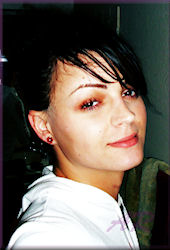
Jamie Sullivan
|
http://www.youtube.com/
|
jamielivefree
|
Born: 1988
Transitioned: Age 21
Height: 178 cm; Weight: 64 kg
Hormone Regime: Began hormones age 19 - 300 mg Spironolactone and 6 mg estrodiol daily, 5mg medroxyprogesterone on a monthly cycle
Surgery: Age 22, facial feminization
|

Final Note: I would like to give a huge thanks to all the girls who have contributed to this page in some way.
More contributions and information are very welcome, and your identity will remain confidential unless you say otherwise. For this page I'm particularly interested to
hear
from any girls who transitioned or started hormonal treatment by age 18, and had SRS by 21.
|
Copyright (c) 2011, Annie Richards












 Willem, age 12 and Kristel (born Jeremy) age 11, for more information see Lynn Conway's site.
Willem, age 12 and Kristel (born Jeremy) age 11, for more information see Lynn Conway's site. Maxine (born Maksim) transitioned at age 14, had a "nose job" at 16, started hormones at 17, had SRS at 20 and is shown age 21 in the main picture. (Moldavia / Germany).
Maxine (born Maksim) transitioned at age 14, had a "nose job" at 16, started hormones at 17, had SRS at 20 and is shown age 21 in the main picture. (Moldavia / Germany). 
 Three theories of gender development (click to enlarge)
Three theories of gender development (click to enlarge) John/Joan (David Reimer) - may he RIP.
John/Joan (David Reimer) - may he RIP.
 Zach Avery, age 5
Zach Avery, age 5  The age of realization of gender variance
The age of realization of gender variance

 Nicole Roukema (Netherlands) was born Neils but knew that she was a girl by age 3. She had transitioned by age 13 and plans to have SRS surgery when 18.
Nicole Roukema (Netherlands) was born Neils but knew that she was a girl by age 3. She had transitioned by age 13 and plans to have SRS surgery when 18. Suzannah Fleming, age 6 (inset) and now. She started hormones age 12 with the brave assistance of her mother - a registered nurse.
Suzannah Fleming, age 6 (inset) and now. She started hormones age 12 with the brave assistance of her mother - a registered nurse.




 Campbell, shown age 16, was born a boy but always considered herself a girl. She received no early medical treatment and has had to deal with a male puberty. (UK)
Campbell, shown age 16, was born a boy but always considered herself a girl. She received no early medical treatment and has had to deal with a male puberty. (UK)






 Lauren Foster nee Shipton. She had SRS at age 18 and became a model and actress; she's now married (South Africa / USA)
Lauren Foster nee Shipton. She had SRS at age 18 and became a model and actress; she's now married (South Africa / USA) Kelly at the start of her transition. (UK)
Kelly at the start of her transition. (UK) Oestrogen levels in Women
Oestrogen levels in Women Testosterone levels in Men
Testosterone levels in Men



 Ashlyn Parram (born Lewis) was not allowed to sit an exam at her school because she was wearing a girls uniform, including skirt. The headmaster only relented after being shown the Equality Act 2010. Shown age 11 and 16. (UK)
Ashlyn Parram (born Lewis) was not allowed to sit an exam at her school because she was wearing a girls uniform, including skirt. The headmaster only relented after being shown the Equality Act 2010. Shown age 11 and 16. (UK)










 Wendy (UK) at age 17, when doctors would not prescribe her hormones despite her parents full support for her transition.
Wendy (UK) at age 17, when doctors would not prescribe her hormones despite her parents full support for her transition.

 Kelly van de Veer (Netherlands) had SRS at age 19
Kelly van de Veer (Netherlands) had SRS at age 19  14 year old Jamie (left) and 15 year old Danique are unambiguously girls after their transition. (Netherlands)
14 year old Jamie (left) and 15 year old Danique are unambiguously girls after their transition. (Netherlands) Roberta Close started hormones at age 16. Even as an undis-covered teenager, her attraction to and success with men is undoubted. (Brazil)
Roberta Close started hormones at age 16. Even as an undis-covered teenager, her attraction to and success with men is undoubted. (Brazil)

 These young transsexual women featured in the July 2002 edition of the UK magazine Marie Claire.
Nina (second from left) was 22, Jamie (back, fourth from left) was 16, and Zoe (first from right) was 21.
Jamie eventually had her SRS just five days after her 18th birthday - as soon as the Standards of Care permitted and her surgeon could perform the operation.
These young transsexual women featured in the July 2002 edition of the UK magazine Marie Claire.
Nina (second from left) was 22, Jamie (back, fourth from left) was 16, and Zoe (first from right) was 21.
Jamie eventually had her SRS just five days after her 18th birthday - as soon as the Standards of Care permitted and her surgeon could perform the operation. These four post-operative transsexual women (ages 23-27) from Thailand appeared in some
editions of Maria Claire in 2006, making an interesting contrast to the picture above.
These four post-operative transsexual women (ages 23-27) from Thailand appeared in some
editions of Maria Claire in 2006, making an interesting contrast to the picture above. Jenny Hiloudaki was born Yiannis in 1981. He began secretly taking female hormones when just 13, and had Sex Reassignment Surgery age 20. She was 'outed' at age 29, but two years later was voted 'Greek Woman of the Year'.
Jenny Hiloudaki was born Yiannis in 1981. He began secretly taking female hormones when just 13, and had Sex Reassignment Surgery age 20. She was 'outed' at age 29, but two years later was voted 'Greek Woman of the Year'.






 Success stories: from the left Cadence, Larissa, Kim, Marti, Devon and Jackie
Success stories: from the left Cadence, Larissa, Kim, Marti, Devon and Jackie Other openly transgender teenagers on social media have included, from the left, Maya, Brittney,
Luxeria, Michelle and Vicky.
Other openly transgender teenagers on social media have included, from the left, Maya, Brittney,
Luxeria, Michelle and Vicky.

 Elaine at her college graduation (USA)
Elaine at her college graduation (USA) 
















